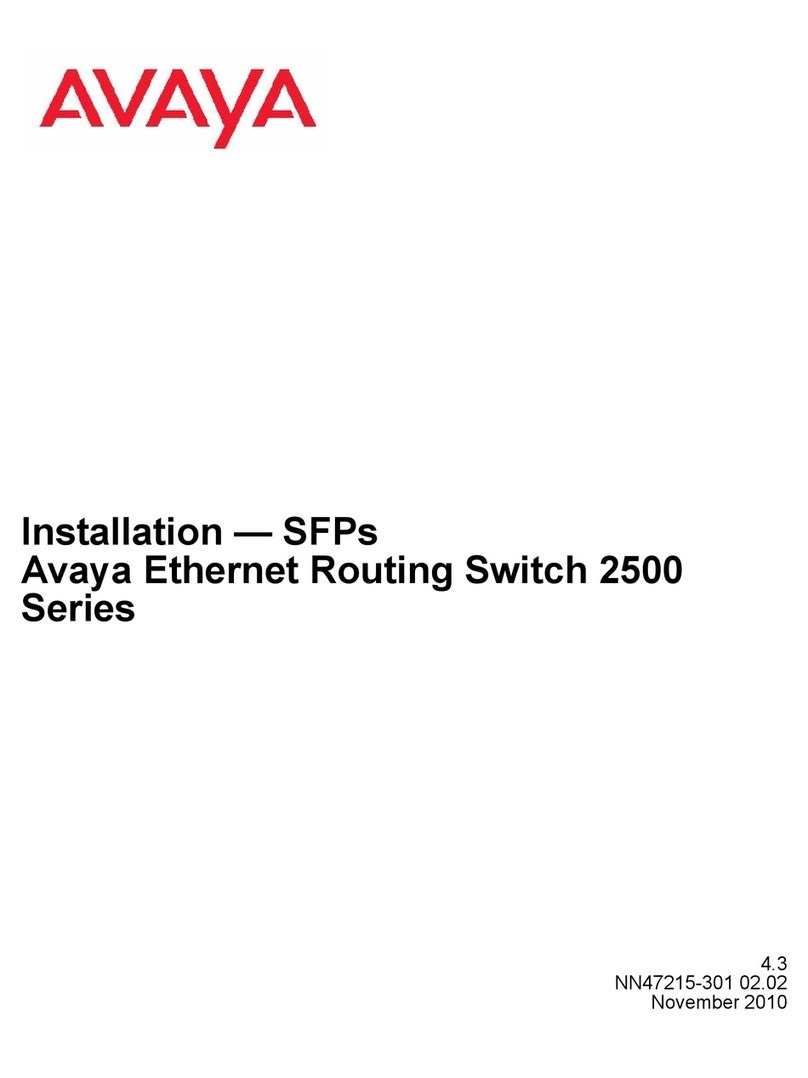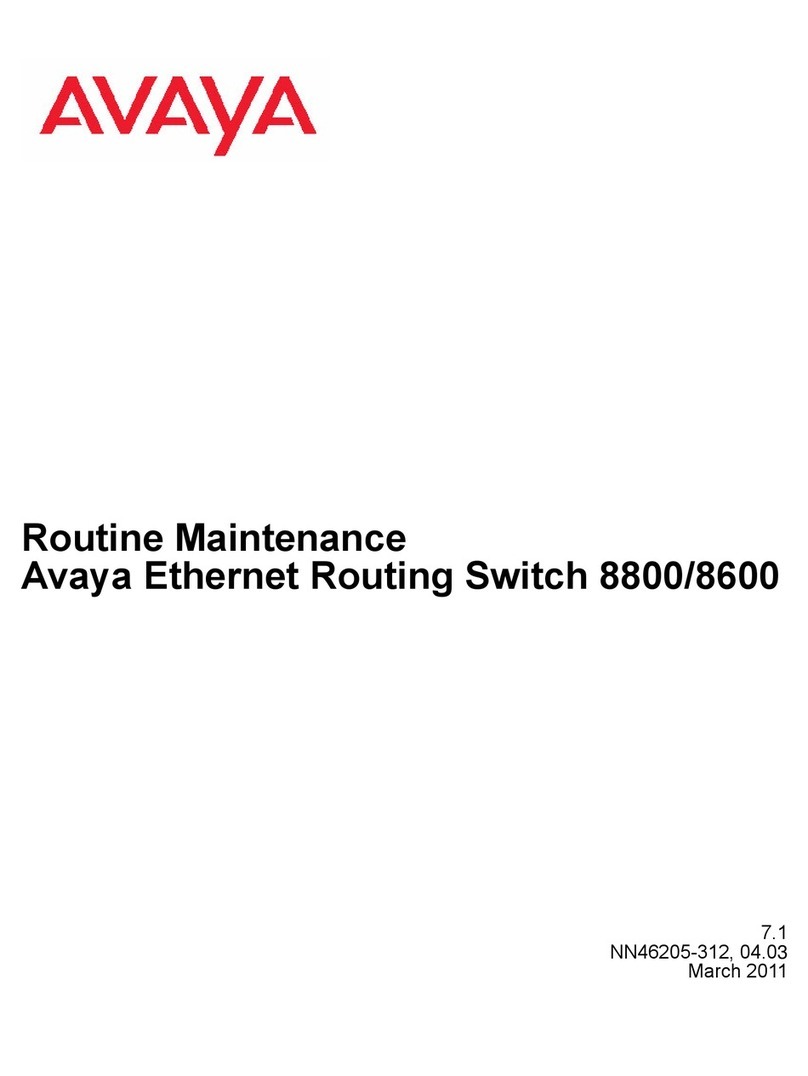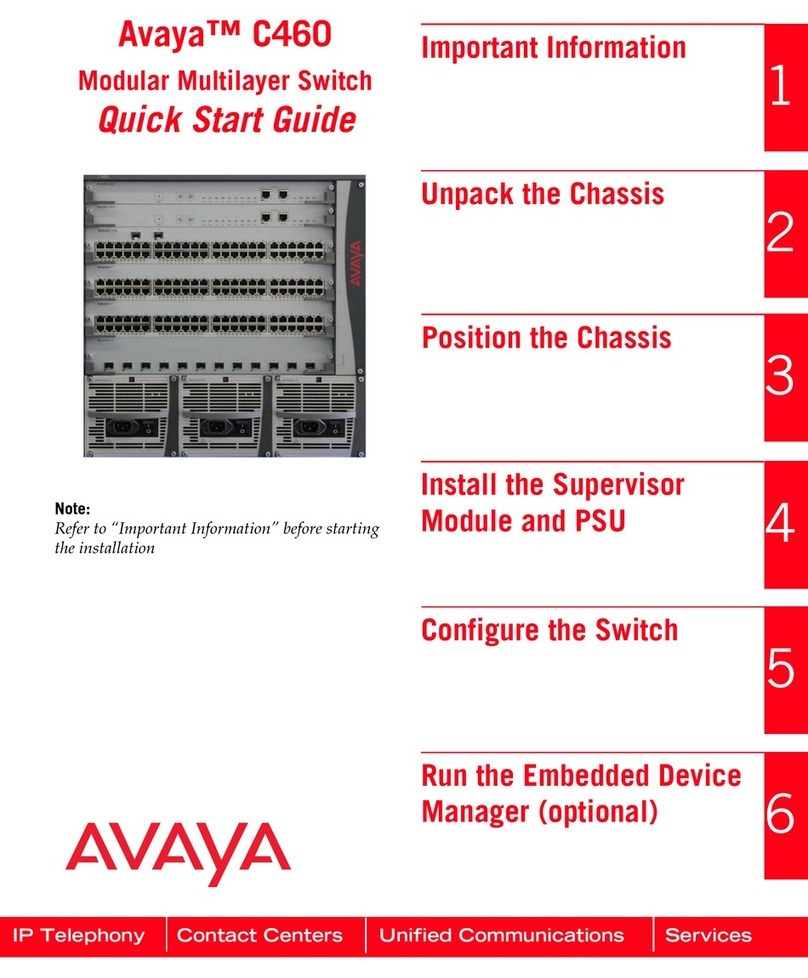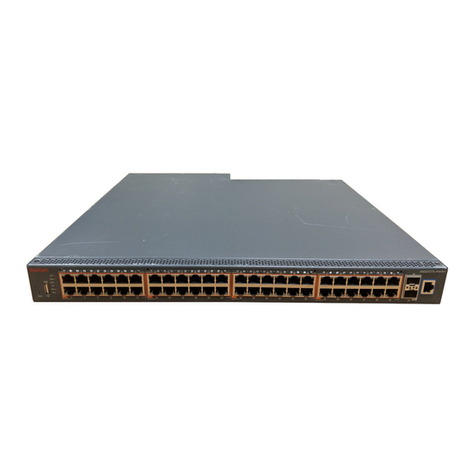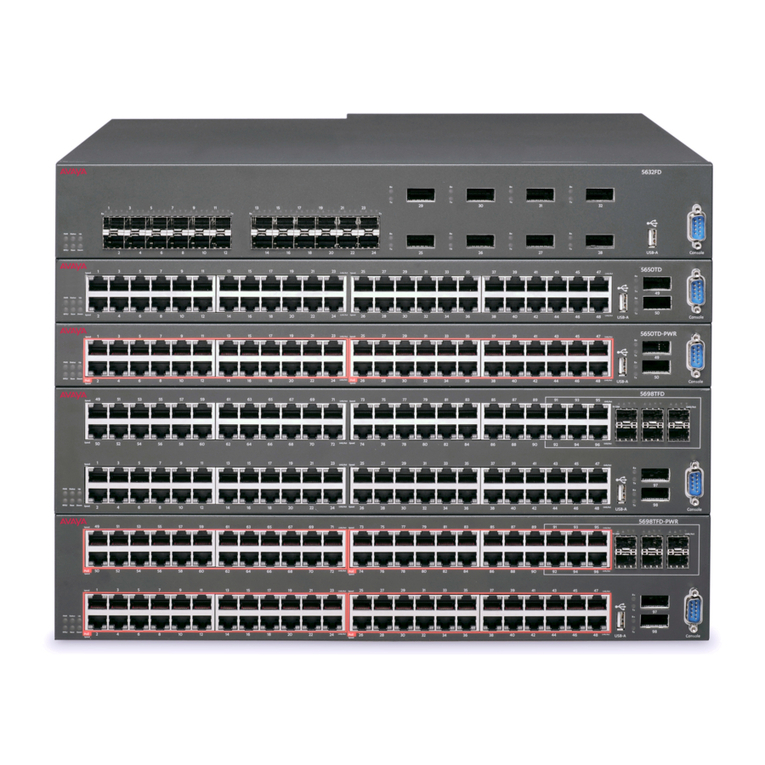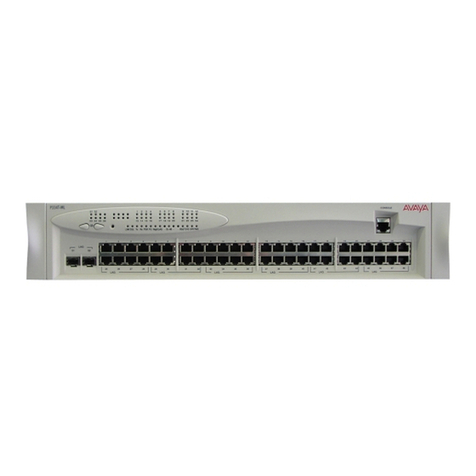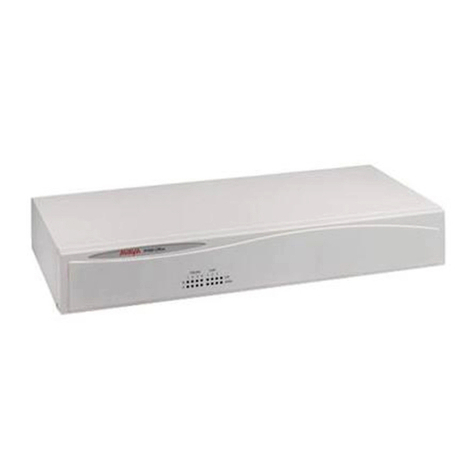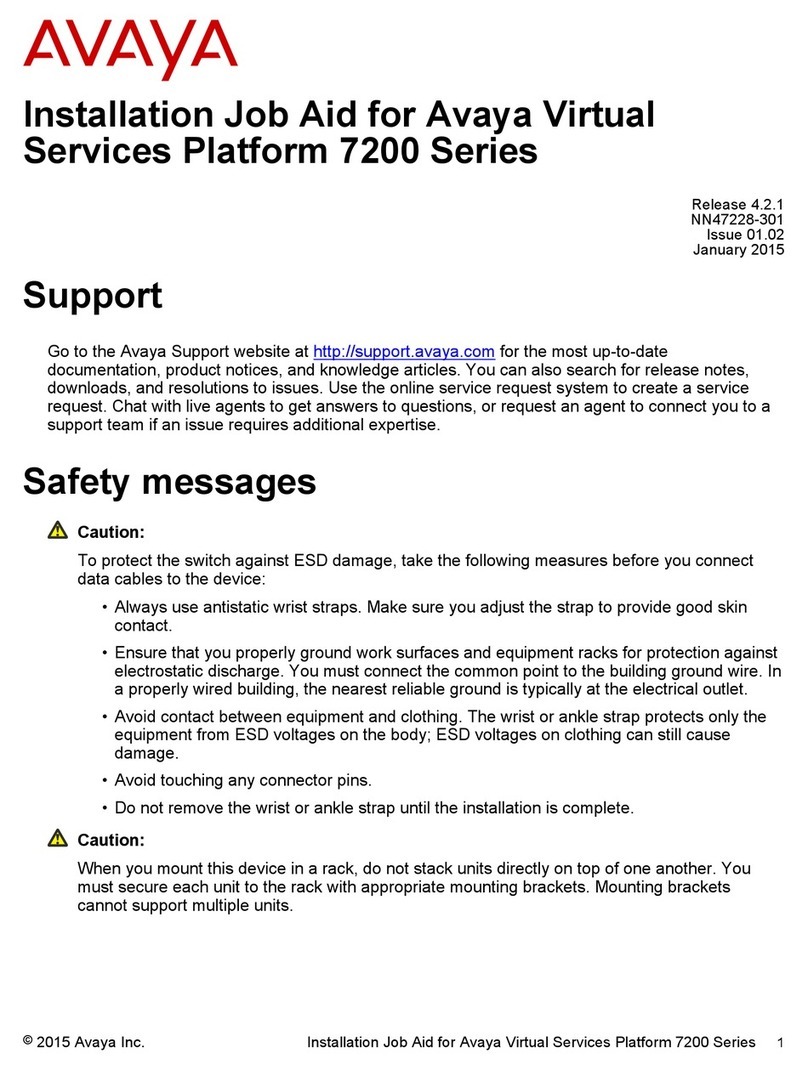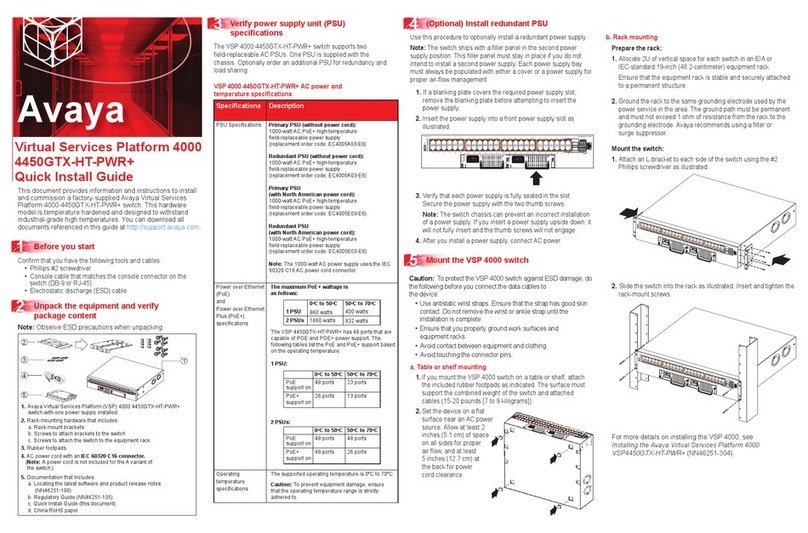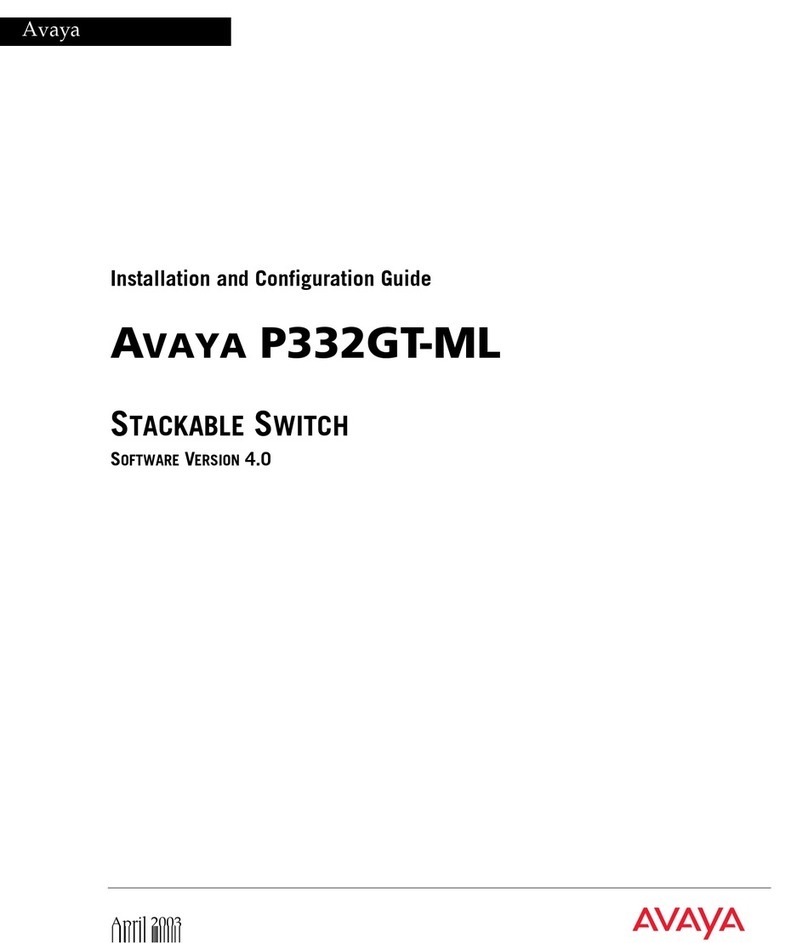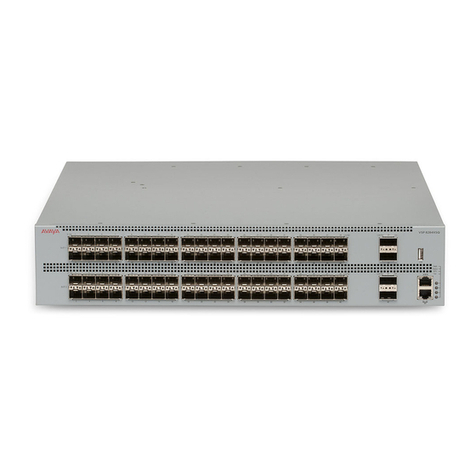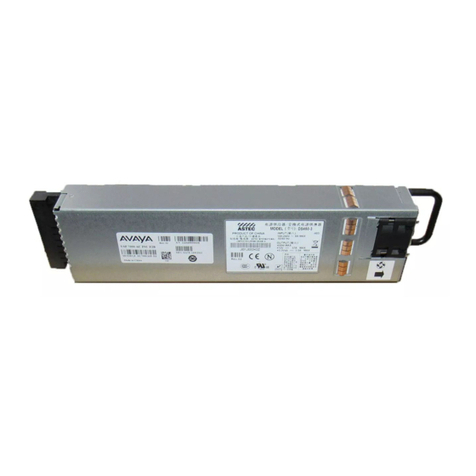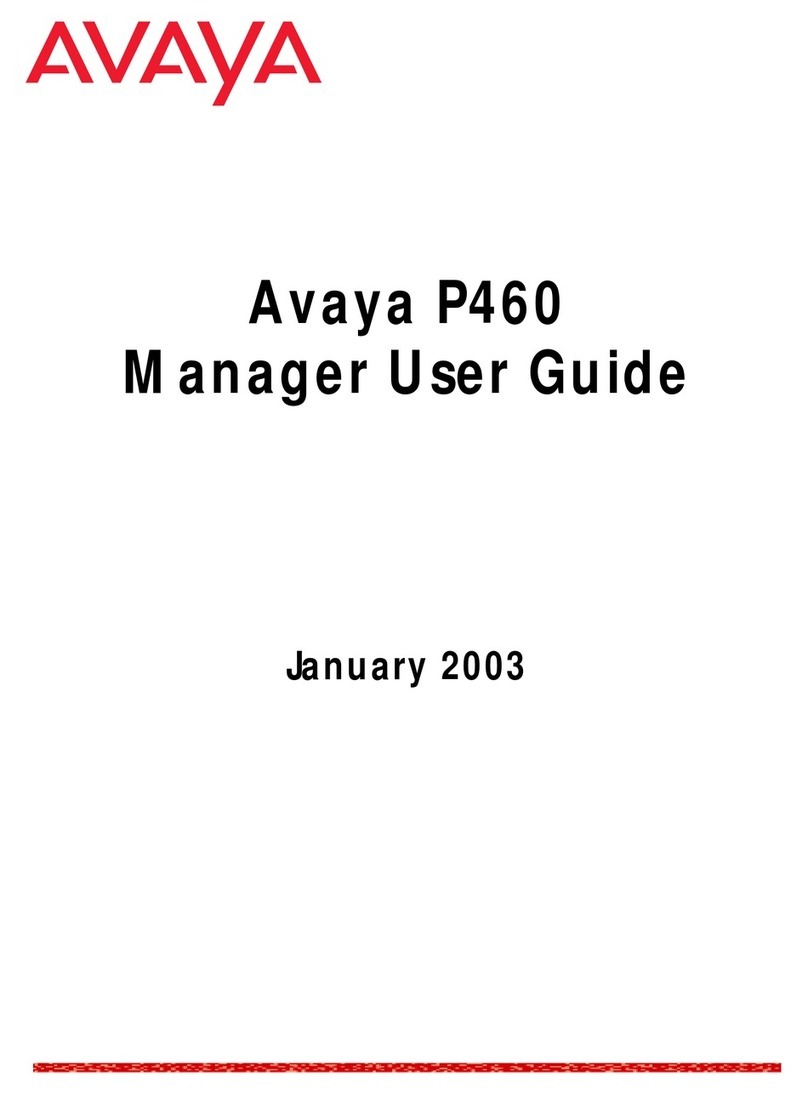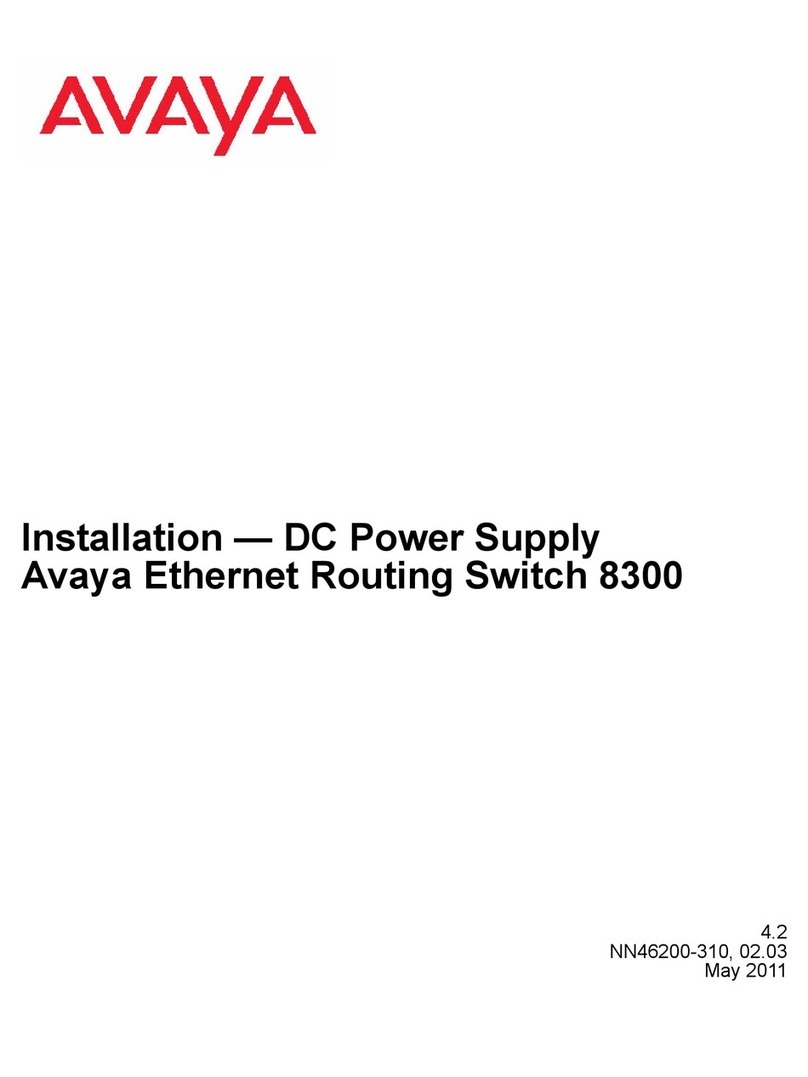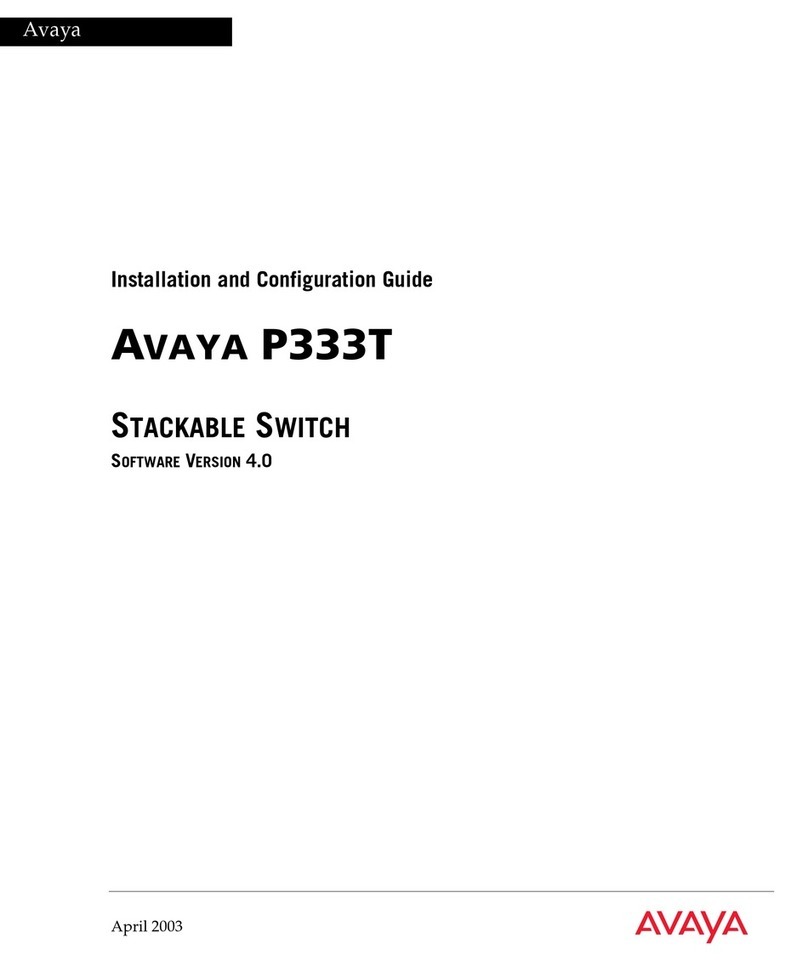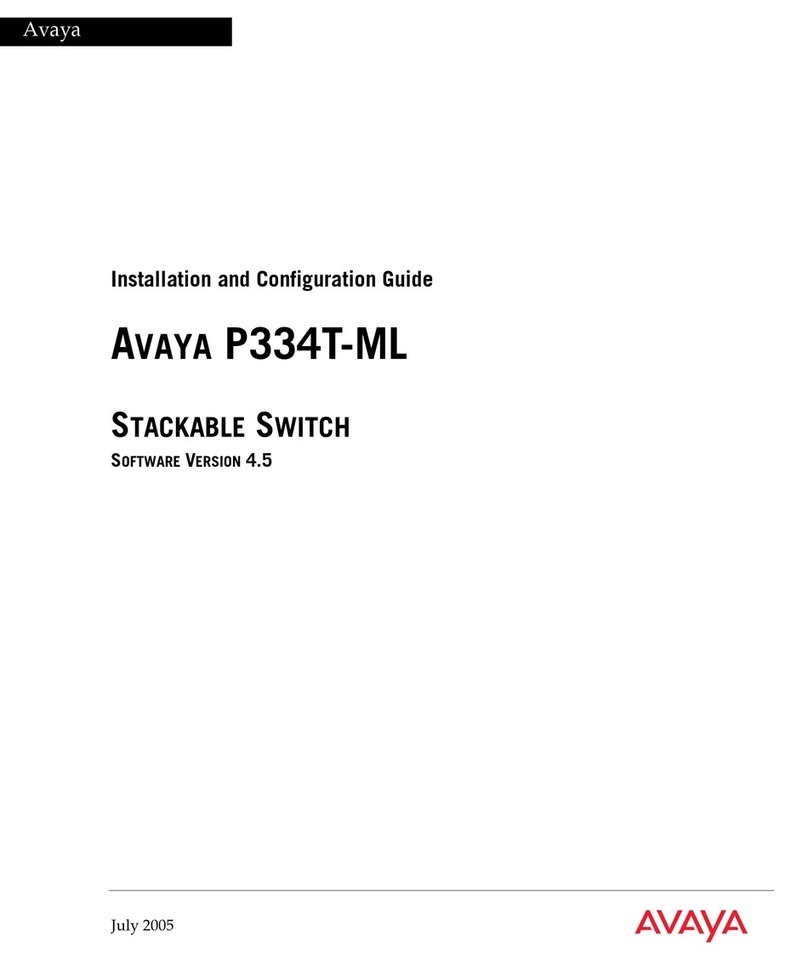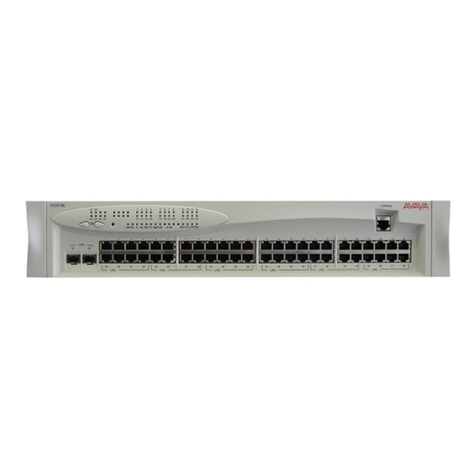
11 Setting IP parameters using the console
port and CLI QuickStart
10 Console Port pin assignments
http://support.avaya.com
1-800-242-2121 (U.S.A.)
1-866 GO-AVAYA
1-866-462-8292 (US Sales)
NN47203-300, 04.01
(700503194 Rev. 04)
© 2015 Avaya Inc.
5cRack mounting singles - ERS 3510GT or
ERS 3510GT-PWR+
To rack mount a single ERS 3510GT or
ERS 3510GT-PWR+ switch:
Use the 3510-Single Rack Mount Accessory
Kit (AL3511003-E6) to mount a single
ERS 3510GT or ERS 3510GT-PWR+ switch
in a standard 19” rack.
1. With the front of the ERS 3510GT or
ERS 3510GT-PWR+ unit facing you,
attach the small bracket from the
optional kit to the right side of the
switch using the flathead
screws provided.
2. With the front of the
ERS 3510GT or
ERS 3510GT-PWR+
unit facing you, attach
the long bracket from the
optional kit to the left side
of the switch using the flathead
screws provided.
3. Slide the switches into the
rack. Insert and tighten the
rack mount screws.
6Wall Mounting - ERS 3510GT or
ERS 3510GT-PWR+
To wall mount an ERS 3510GT or ERS 3510GT-PWR+ unit:
a. Drill two 4.5 mm diameter holes
(separated 108.5 mm apart
horizontally) in the wall or surface
where you want to mount the unit.
Refer to the figure below. WALL SECTION WITH
DRILLED HOLES
2X DRYWALL
ANCHORS
& SCREWS
3510GT AND\OR
3510GT-PWR+ CHASSIS
b. Press fit the plastic body of conical
drywall anchors into each of the
drilled holes.
c. Install a tapping screen into each anchor
and fully set it to expand the anchor into
the wall or surface.
d. Back the screw out from the fully seated
position by 1.5 mm.
e. Slip the ERS 3510GT or ERS
3510GT-PWR+ chassis capture slots
over the exposed screw heads to hang it
from the wall or surface.
3510GT & 3510GT-PWR+ CAPTURE
SLOTS FOR WALL MOUNTING
108.5mm HOLE SEPARATION
7Configuring Stacking
The Avaya Ethernet Routing Switch 3500 Series provides fail-safe stackability.
You can connect up to eight ERS 3500 Series devices in a stack to provide
uninterrupted connectivity for up to 192 to 208 ports. You can manage the
stack as a single unit.
To install/add a unit to a stack, you must change the default mode from
standalone to stacking mode and reboot the unit. See NN47203-303 for
more details.
Note: Stacking is not available for ERS 3510GT or ERS 3510GT-PWR+
switches. Stacking is only supported with switches operating with Release 5.1
or later software.
The Avaya Ethernet Routing Switch 3524GT, 3524GT-PWR+, 3526T,
3526T-PWR+, 3549 GTS, 3549 GTS-PWR+, 3550T, and 3550T-PWR+ rear
panel provides a Unit Select switch, Cascade Down port, and Cascade Up
port for stacking purposes as shown below:
Base Unit Select Switch – used to designate the base unit
in a stack.
Cascade Down and Cascade Up ports – used to connect a switch to the
next unit in the stack through a cascade cable. Connect one end of the
Cascade Down cable to the Cascade Up port of the next switch in the stack
(shown in the three-switch stack connection block diagram below):
Base Unit Select switches
To create a stack connection, order the appropriate Avaya Ethernet Routing
Switch 3500 Series cascade cables to ensure fail-safe stacking. For stacking
three or more units (maximum eight units per stack), order the 46 cm, 1.5 m,
or 3 m cables as applicable (see “Before You Start” – step 3 for Order Codes).
1. Ensure that all switches for the stack are rack mounted.
2. Slide the Unit Select switches on the back of the units to the appropriate
position, depending on whether they are a base unit or non-base unit:
• Base Unit (Unit 1) - Slide the Unit Select switch to the RIGHT
• Non-Base Unit (Units 2-8) - Slide the Unit Select switch to the LEFT
NOTE: The Base Unit Select switch defaults to be in the Non-Base position.
Only one switch in the stack must have the Base Unit Select switch set to the
Base position.
ERS 3524GT/3524GT-PWR+ rear panel
ERS 3526T/3526T-PWR+ rear panel
1 – Base Unit
2 – Cascade/Stack Cable
3 – Cascade/Stack Cable
(Used for return)
MODE
Standalone
Stacking
Port 25
Cascade DownCascade Up
Port 26
Unit Select
Base
MODE
Standalone
Stacking
Port 25
Cascade DownCascade Up
Port 26
Unit Select
Base
MODE
Standalone
Stacking
Port 25
Cascade DownCascade Up
Port 26
Unit Select
Base
1
2
3
Unit 1
Unit 2
Unit 3
1 = Cascade down port
2 = Cascade up port
3 = Base Unit Select Switch - used to
designate the Base Unit in a stack.
When set to the RIGHT position, this
unit acts as the Base Unit for the stack
MODE
Standalone
Stacking
Port 25
Cascade Down Cascade Up
Port 26
Unit Select
Base
123
MODE
Standalone
Stacking
Port 27
Cascade Down Cascade Up
Port 28
Unit Select
Base
123
1 = Cascade down port
2 = Cascade up port
3 = Base Unit Select Switch - used to
designate the Base Unit in a stack.
When set to the RIGHT position, this
unit acts as the Base Unit for the stack
Because stack parameters are associated with the base unit, the physical
stack order depends on the base unit position and whether you configure the
stack cascade up (stack up) or cascade down (stack down). This designation
depends on the stack cabling arrangement.
IMPORTANT: Avaya recommends that you use a Cascade Down
configuration.
3. Connect stacking cables as required for a Cascade Up (stack up) or
Cascade Down (stack down) configuration as shown below:
Cascade Down - Recommended configuration
Cascade Up configuration
1 = Base unit
2 = Last unit
3 = Cascade/Stack Cable
4 = Cascade/Stack Cable
(Return cable to make stack
resilient. Use longer stack
cable if required.)
1 = Base unit
2 = Last unit
3 = Cascade/Stack Cable
4 = Cascade/Stack Cable
(Return cable to make stack
resilient. Use longer stack
cable if required.)
8
Powering Up
Connect the AC power cord to the back of the switch or switches, and then
plug the other end of the cord into an AC power outlet. If powering up a stack
of switches, power on all switches together.
Check the front-panel LEDs as the device powers on to be sure the PWR LED
is lit. If not, check that the power cord is plugged in correctly.
Warning: You must use a power cord set approved for the 3500 Series
switch and the power receptacle type in your country.
The 3500 Series switches begin switching data after the switch is powered up
and has loaded the agent code software which is indicated by both the PWR
and Status LEDs being lit solid green.
Front Panel 3510GT & 3510GT-PWR+
Status
PWR
Status
PWR
Up/28
Down/27
Base
Front Panel 3526GT & 3526GT-PWR+
Front Panel 3524GT & 3524GT-PWR+
Status
PWR
Up/26
Down/25
Base
9
To set IP parameters using the console port and CLI Quickstart, perform the
following tasks:
a. Connect a terminal to the console port of the switch.
Any terminal or PC with an appropriate terminal emulator can be used as
the management station. The Terminal emulation settings table below lists
the parameters that must be used with any terminal emulation software
used to connect to the switch.
To connect to the switch
console port, you require
a console cable with an
RJ-45 connector to match
the console port on
the switch.
b. Set the terminal protocol on the terminal or terminal emulation program to
VT100 and VT100/ANSI.
c. Connect to the switch using the terminal or terminal emulation application.
d. The Avaya switch banner appears when you connect to the switch through
the Console port. Enter Ctrl+Y and type the following CLI commands:
•enable
•install
The ERS 3500 will set a default IP address of 192.168.1.1/24 by default if
the switch does not get its IP from another source.
The CLI Quickstart welcome screen helps you to enter the information
requested at each prompt.
CLI Quickstart welcome screen
#################################################################
Welcome to the ERS3500 setup utility.
You will be requested to provide the switch basic connectivity settings.
After entering the requested info, the configuration will be applied and
stored into the switch NVRAM.
Once the basic connectivity settings are applied, additional
configuration can be done using the available management interfaces.
Use Ctrl+C to abort the configuration at any time.
#################################################################
Please provide the Quick Start VLAN <1-4094> [1]:
Please provide the in-band IP Address[192.168.10.6]:
Please provide the in-band sub-net mask[255.255.255.0]:
Please provide the Default Gateway[0.0.0.0]:
Please provide the Read-Only Community String[**********]:
Please provide the Read-Write Community String[**********]:
Please provide the in-band IPV6 Address/Prefix_length[::/0]:
Please provide the in-band IPV6 Default Gateway[::]:
Do you want to enable the DHCP server? y/n [n]:
#################################################################
Basic stack parameters have now been configured and saved.
#################################################################
You are now ready to use the ERS 3500 Series switch in your network
installation. You can use the run ip office ACLI script to configure parameters
according to Avaya best practices for converged solutions. See the Getting
Started guide (NN47203-301).
Quick CLI Command guide:
boot - reboot the switch
boot default - reboot and use the factory default configurations
restore factory - default <-y> - reset the switch to factory default configurations,
use -y option for no prompts
Name
RTS (Ready To Send)
DTR (Data Terminal Ready)
TXD (Transmit Data)
DCD (Carrier Detect)
GND (Ground)
RXD (Receive Data)
DSR (Data Set Ready)
CTS (Clear To Send)
Requirement
Optional - can swap or link with pin 8
Optional
Mandatory
Optional
Mandatory
Mandatory
Optional - can swap or link with pin1
Optional – can swap or link with pin1
RJ - 45 Jack
1
2
3
4
5
6
7
8
RJ - 45 8-Pin Female Jack
The console port is the RJ-45 port shown with a blue border outline on the
front of your ERS 3500 Series switch (note orientation). The port is labeled
console, and can be used to establish a management terminal connection to
the switch.
You can use an RJ-45 to DB-9 cable to connect the switch console port to
your management terminal. Avaya recommends you use the Avaya RJ-45
Console Cable part number: AL2011022-E6. Alternatively a DB-9 to RJ-45
adapter or other suitable console cables can be used - the maximum length of
a console cable is 25 feet (8.3 meters). The following table describes the
RJ-45 console port pin-out information. You can use the pin-out information to
verify or create a console cable for use with your maintenance terminal.
Mean Time Between Failure (MTBF) for ERS 3500 Series
ERS 3510 892,667
ERS 3510-PWR+ 673,542
ERS 3524 657,619
ERS 3524-PWR+ 336,357
ERS 3526 645,510
ERS 3526-PWR+ 332,778
ERS 3549GTS 471,289
ERS 3549GTS-PWR+ 259,615
ERS 3550T 446,323
ERS 3550T-PWR+ 237,581
Model Estimated MTBF Hours
Console port
For more related information, go to
http://support.avaya.com
to download the following ERS 3500 guides:
•
Regulatory Reference (NN47203-100)
•
Installation Job Aid (NN47203-303)
•
Release Notes (NN47203-400)
•
Getting Started (NN47203-301)
•
Documentation Reference (NN47203-101)
ERS 3550T/T-PWR+ rear panel
MODE
Standalone
Stacking
Port 51
Cascade Down Cascade Up
Port 52
Unit Select
Base
12 3
1 = Cascade down port
2 = Cascade up port
3 = Base Unit Select Switch - used to
designate the Base Unit in a stack.
When set to the RIGHT position, this
unit acts as the Base Unit for the stack
Front Panel 3549GTS & 3549GTS-PWR+
Status
PWR
Up/51
Down/50
Base
ERS 3549 GTS/GTS-PWR+ rear panel
MODE
Standalone
Stacking
Port 50
Cascade Down Cascade Up
Port 51
Unit Select
Base
123
1 = Cascade down port
2 = Cascade up port
3 = Base Unit Select Switch - used to
designate the Base Unit in a stack.
When set to the RIGHT position, this
unit acts as the Base Unit for the stack
Front Panel 3550T & 3550T-PWR+
Status
PWR
Up/52
Down/51
Base
